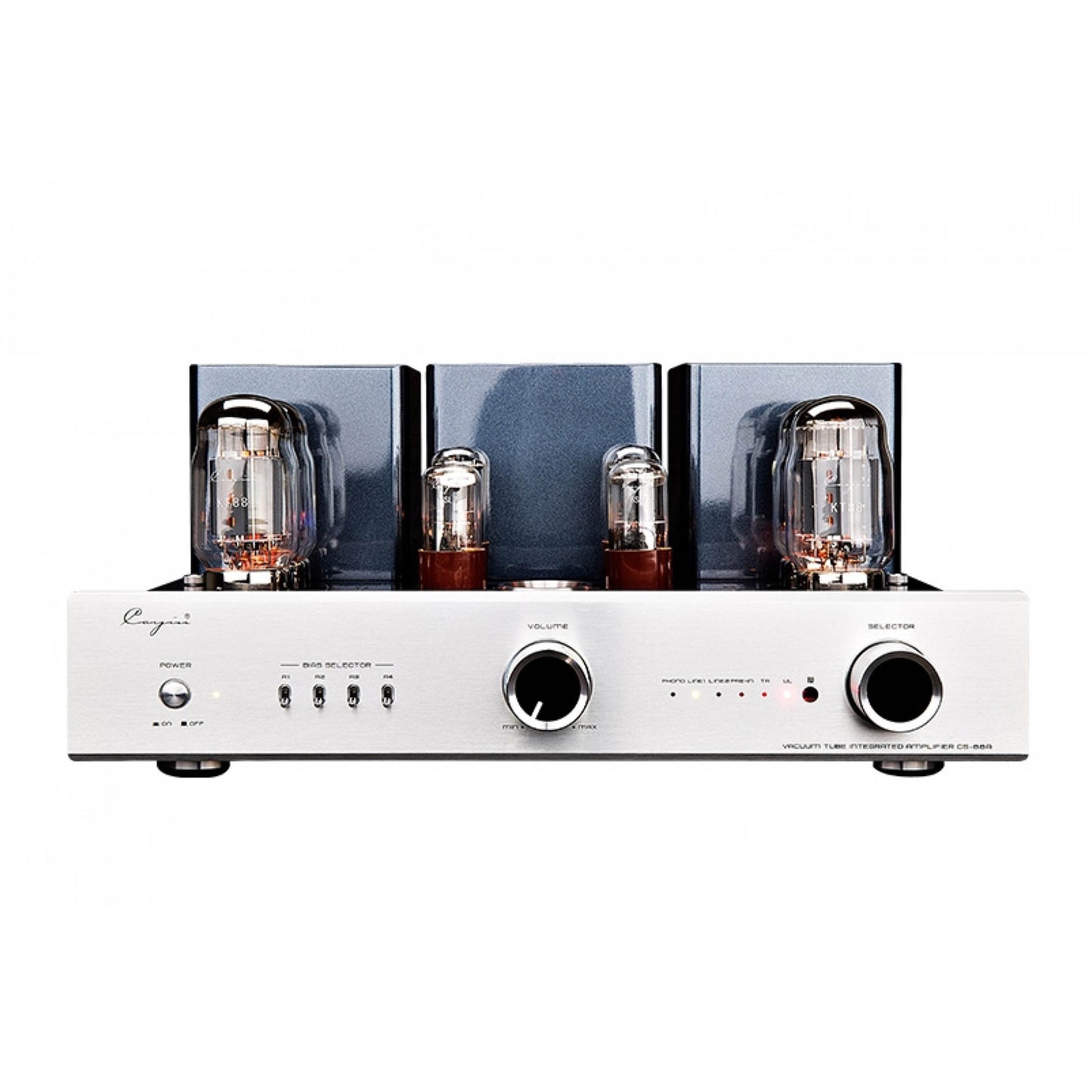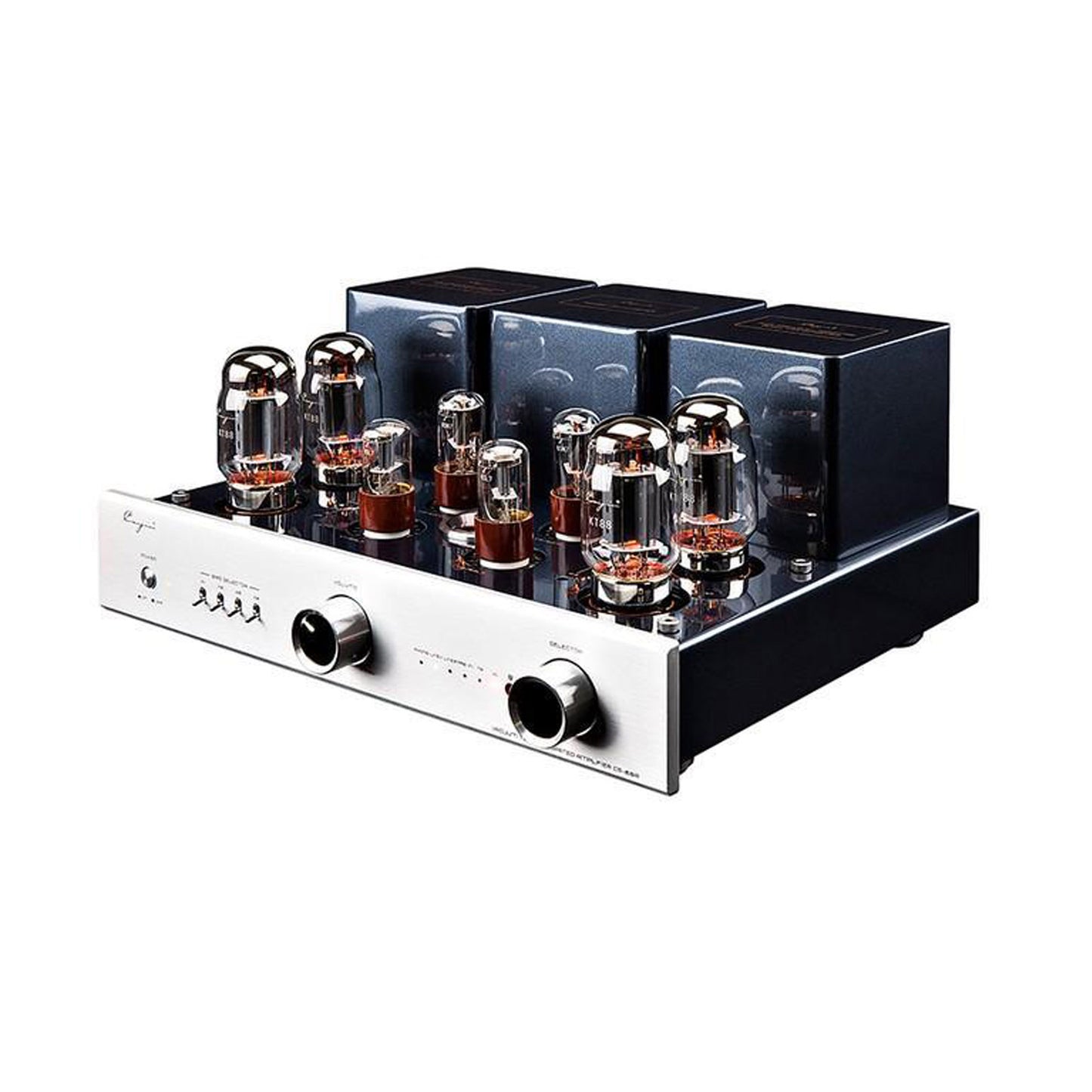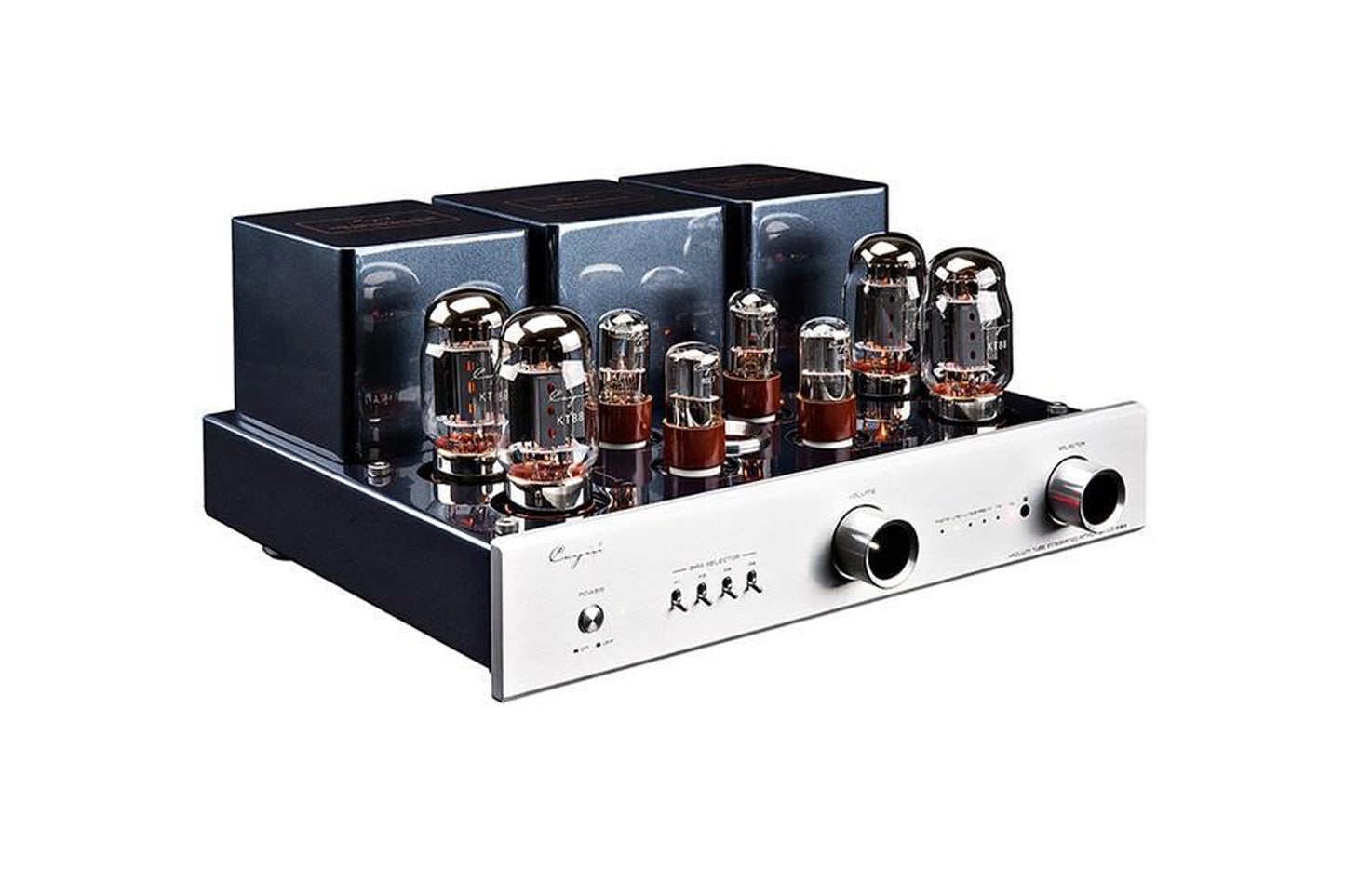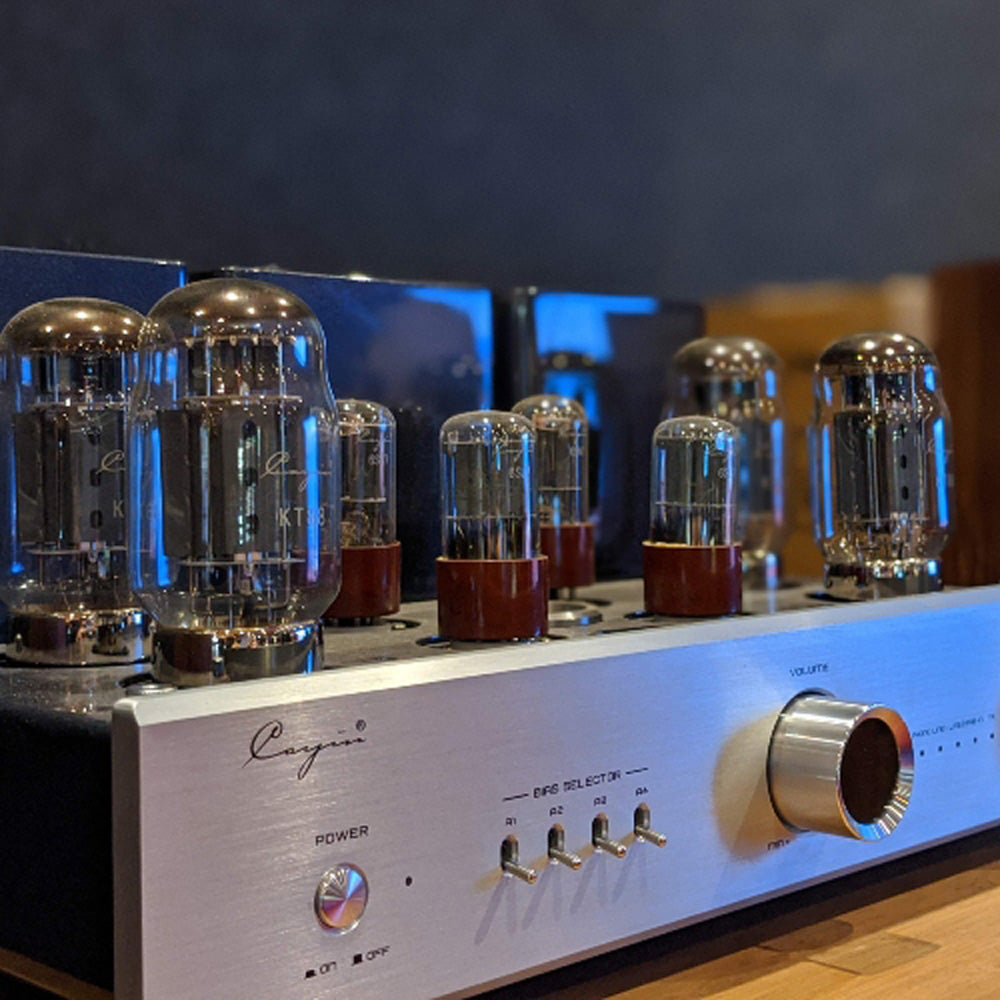



About The Cayin CS-88A MK2 Stereo Amplifier
Occupying the sweet spot in the market, the Cayin CS-88A MK2 Stereo Amplifier is that perfect blend of features, power output and price. Yes, it is a classic design using Valves for the ultimate in analogue sound. Yes, it is made in China, but at half the price (minimum) you'd expect to pay for a USA equivalent. Makes you wonder why you'd ever buy a solid-state amp?
The Zhuhai Spark Electronic Equipment Company (cool name) was founded in Guangdong, China in 1993 and is devoted to the design and production of great sounding high-end audio equipment under the brand name Cayin.
And before you write this fine company off just because it designs & manufactures its products in China, please be aware of a couple of points: firstly, nearly all the products we stock from established audio companies, such as Audiolab, Cambridge Audio, Marantz and NAD, are also manufactured at state of the art facilities in China. The second point is that the Chinese domestic market is huge and there are many audiophiles who not only buy home grown products (like Americans who buy McIntosh) but also own and operate serious audio companies such as Cayin. Cayin was specifically set up to supply the quality end of the audio market and specialise in valve amplifiers based on the iconic Saul B. Marantz Models 7 and 8 of the 1960's which were famous for their sweet, natural and exceptionally musical sound.
This CS-88A model is a fine example of Cayin's design expertise and is handcrafted with point-to-point wiring and two wide bandwidth EI output transformers to provide the current to bring music to life.
The Cayin CS-88A is a refined, polished, upgraded version of the highly regarded A-88T MK2. Unlike valve amps of yore, all functions on the CS-88A are remote controlled including the superb motorised Alps volume-control. In a nice touch, as well as two line level inputs, the CS-88A also sports an MM phono input allowing you to connect your trusty turntable. It weighs in at nearly 30 kilos (blame those output transformers) and has a complement of two 6SL7s & two 6SN7s in the preamp stage and four powerful KT88s in the output stage. This gives a very healthy 45 watts in Ultra-Linear mode and a still very satisfactory 25 watts in Triode mode.
Ultra-Linear & Triode Mode: And what, pray tell, are Ultra-Linear & Triode modes? Glad you asked. First of all, there are three common types of Valves/Tubes (Valves in British English, Tubes in American English) used in the output stage of an amplifier: Triodes, Pentodes & Tetrodes.
Triodes (300B etc) are used in Single Ended Triode (SET) amplifiers that only output a few (very pure) watts. These amps rarely venture above 7 or 8 watts which means the speakers they can be used with need to be extremely efficient. This type of amplifier and this type of speaker are the exception rather than the rule.
Far more common are Push-Pull valve amplifiers, such as the CS-88A featured here, which use either Pentodes (EL34 etc) or Tetrodes (KT88 etc) running in Ultra-Linear to provide a usable amount of wattage (30 – 80 watts) for the vast majority of speakers. Some companies, in order to offer the pure sound of Triodes in a push-pull amplifier, provide a way to switch the Pentode or Tetrode output valves into Triode mode. Although this generally gives a sweeter sound, the trade off is a much lower power output of approximately half the normal Ultra-Linear operation. Depending on your speakers, the size of the room and the volume you like to listen at, Triode mode may or may not be a happy match with you and your system.
Valve/Tube Rolling: Unlike transistor amps where the output transistors are soldered in, most valves are fitted to valve sockets which allow the valve to be easily changed, either for a replacement, in the case of failure, or for a different type of valve. This practice of swapping valves to different models or different versions of the same valve is known as valve/tube rolling and allows you to fine tune the sound of the amplifier to your liking. Some of our customers have a host of valves they regularly change depending on their mood or the music they are playing. Of course you do need to be careful to only use the types of valves the manufacturer suggests – in the case of the Cayin CS-88A it is a choice between the supplied KT88's or the ever popular EL34's which are readily available. A valve selection switch is provided on the rear of the amplifier.
Valve vs Solid State
The whole Valve/Tube or Solid-State dilemma is not as complicated as you might think. Once you accept the reality that a valve amp and a solid-state amp are very different in how they operate, you'll perhaps better understand that each have their own traits.
The biggest difference between them is that a solid-state amp is driven by current through the output devices and a valve is driven by voltage. Voltage alone can't drive a speaker, hence the reason for needing output transformers. You'll notice most stereo valve amps have 3 large, heavy objects, typically at the rear. They are a power transformer and two output transformers (one for each channel) that convert the voltage from the output valves to current at the speaker connections. A solid-state amp typically has a single power transformer and no output transformers. However, a solid-state output transistor and a valve basically do the same thing. One doing it in silicone with current and the other doing it in a glass vacuum with voltage.
Do they sound different? Yes, they do. However, some valve companies make their valve amps sound more solid-state like (for power) and some solid-state products can sound very valve-like. A key difference is that a valve product will require a small amount of upkeep and maintenance. For most who desire the benefit of valves, it's a small price to pay. Others just don't want to maintain an amp once installed.
Back to the sound. First, let's squelch the myth that valve amps don't have strong or controlled bass. Today, that couldn't be further from the truth. Let's also put aside the thought that solid-state amps aren't smooth. Like any product from any manufacturer, all amplifiers have a certain inherent sound signature which will attract different people. There are benefits and drawbacks to each, but one must weigh each depending on what you are looking to achieve in your audio system both in terms of sonics and upkeep as well as taking the rest of the system into consideration.
So, what are the benefits of each? Generally speaking, valves offer a greater sense of bloom, more texture and realism to vocals and instruments and a richer midrange. Solid-state usually offers more watts per dollar, faster sound and greater detail. Once again these are generalisations. If you have a system that overall is a bit harsh or fatiguing, chances are you could greatly benefit from a valve amp. On the other hand, if your system is flat, sluggish, or too soft sounding, perhaps a quality solid-state amp is the way to go. Other factors of particular importance are speaker load. Some speakers (although few today) require lots of power and very low impedance driving capabilities. In that scenario, a solid-state amp may do better. But, if your speakers have a moderate impedance curve (6 to 8 Ohms) and are of average efficiency (86dB or above), a valve amp can redefine your definition of what a great audio system can sound like.
Our Review
Let's face it. You either GET valve amps, or you don't. It's the same kind of allure that has attracted people back to vinyl. They're a little more hands, on a little more involving and that warm glow in low light sure does set the mood. Don't be fooled into thinking though that valve amps only work well with record players. Oh no, in fact you could almost say that digital music played back from music streamers or CD players provide the perfect match for a valve amp. Valve amps seem to have a certain richness to their sound that perfectly complements the clarity of digital.
The CS-88A, with it's tonally neutral voicing, natural timbre and spicy dynamics is a great match with a digital source and we have spent many a happy hour listening to it produce beguiling sounds fed with everything from an entry level Sonos player all the way to a state-of-the-art $10K Naim streamer. The Cambridge Audio music streamers, in particular, are an excellent match with this amp, resulting in a system that not only sounds great but is reasonably easy on the wallet.
Main Features & Specifications
Note: Features & Specifications Subject To Change Without Notice. E&OE.
Product Reviews
Product Questions





